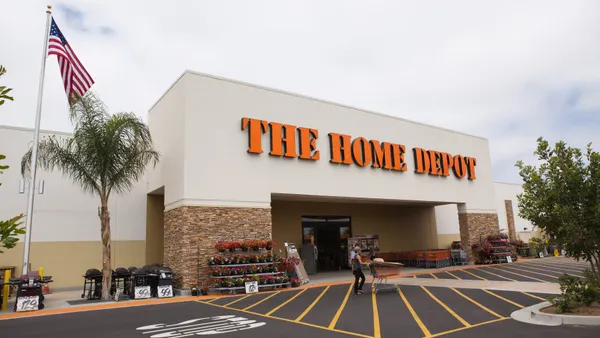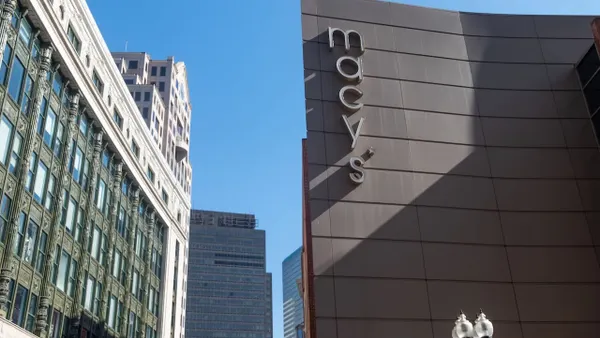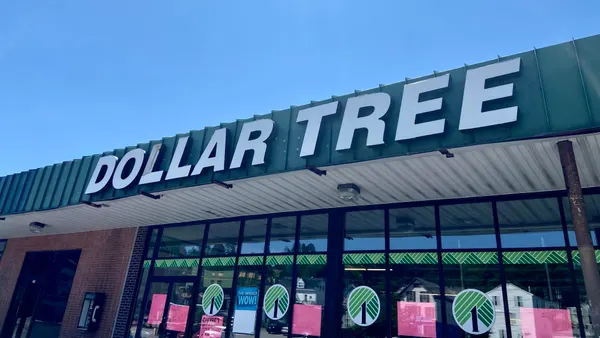UPDATE: September 11, 2018: Hudson's Bay Co. on Tuesday said it has agreed to a joint venture with Signa Holding's Karstadt that would combine Hudson's Bay's European operations with those of its rival to form a retailer with annual revenue of €5 billion (or $5.79 billion U.S.). Hudson's Bay company would own 49.99% of the JV and use proceeds from the deal (about $468 million in U.S. dollars) to pay down debt. "The creation of a stronger operator in Europe allows us to focus our attention on our North American banners, helping to ensure we are making the right strategic decisions to drive performance and profitability within those businesses," Hudson's Bay CEO Helena Foulkes said in a statement.
Dive Brief:
- Hudson's Bay Co. on Friday acknowledged that it is exploring a possible joint venture with Signa Holding, which operates one of the department store retailer's biggest competitors in Europe and last year offered to buy HBC's German unit.
- HBC told investors in a statement that it had "signed a non-binding letter of intent with respect to the exploration of a potential joint venture" with Signa. The company cautioned that any potential deal was still contingent on many factors and the approval of the board.
- Typically reticent around M&A talks, as most corporations are, HBC broke form in confirming it had signed a letter of intent and was talking with Signa about the venture. It did so, the company said, because of media reports, including in the German magazine WirtschaftsWoche and Wall Street Journal, that HBC had already agreed to sell half of its European business to Signa. In its statement Friday, HBC said that "contrary to recent reports it has not signed a binding agreement to sell or combine its European business or properties."
Dive Insight:
HBC's quest to unload assets continues. It wasn't even five months ago that the department store retailer's CEO told investors, after rejecting Signa's $3.5 billion offer for its German unit, that it was confident it could go alone in Europe and bring returns to shareholders.
"Our European business and related real estate assets represent critical components of our long-term strategy and we continue to have a high degree of confidence in our ability to drive results across our iconic retail banners," HBC Executive Chairman Richard Baker, said in February while serving as interim CEO.
But apparently the company wasn't done dancing with Signa. It comes as little surprise, given that HBC, under pressure from activist investors to return cash to shareholders and turn around its performance, has been selling assets wherever it sees the right opportunity.
The Canadian retailer's loudest activist, the hedge fund Land & Buildings, called on the retailer in the fall to "seriously consider" Signa's offer. In the end, HBC found it too low.
But before and since, it has made plenty of other moves to cash in assets. It has sold its Manhattan Lord & Taylor flagship and the Vancouver flagship for the namesake brand. Last month, it sold off the Gilt e-commerce unit to Rue La La after buying it for $250 million in 2016. In 2015, the company put many of its owned properties into a joint venture with Simon Property Group, which some investors want HBC to put up for IPO.
Along with the asset sales, HBC has brought in a new CEO in Helena Foulkes and hired advisers to help it revive, or possibly sell, the ailing Lord & Taylor business. But all this has not quieted Land & Buildings founder Jonathan Litt. In June, Litt pointed to Nordstrom and Macy's as department store peers who have been able to improve their performance in recent months. Litt suggested, without elaborating, that HBC could even "join" Macy's.
That may be a stretch, at the moment, but HBC has already gone through a profound shift, from being the potential buyer of a major rival (Macy's and Neiman Marcus were both reported targets last year) to being a seller of major assets once considered strategic linchpins.














